by Guy Norris in Albuquerque
Cutaway drawing by Tim Hill
Certification of the Eclipse 500 is expected in June. On the outside, the very light jet looks conventional – but inside, the VLJ bristles with technical innovation
Not since Joe Sutter and the Boeing 747 have one person and one product been credited with so much potential to change aviation. Yet anyone looking for a mythical “Eureka!” moment behind the launch of the Eclipse 500 very light jet (VLJ) is in for a disappointment, says Eclipse Aviation president Vern Raburn. Instead, the genesis, and some would say genius, of this game-changing concept was the simple question: “Why hasn’t anyone done this before?”
The innovation that gave birth to the Eclipse 500, and sparked today’s wave of VLJs, was the idea of designing a jet aircraft with operating costs so low it would compete directly with the car. Raburn predicted the breakthrough would regenerate general aviation, make it a viable alternative to road transport and therefore enable massive business opportunities to be tapped in ways that were impossible or impractical before.
Continued below
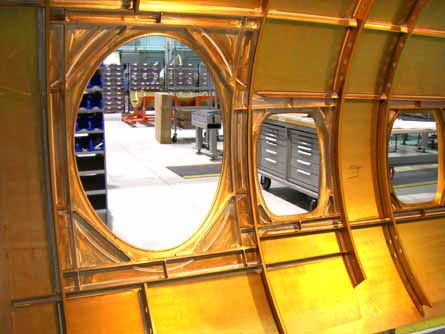 |
| The emergency hatch and adjacent cabin window surround are machined in a single section before being friction stir welded to the cabin skin |
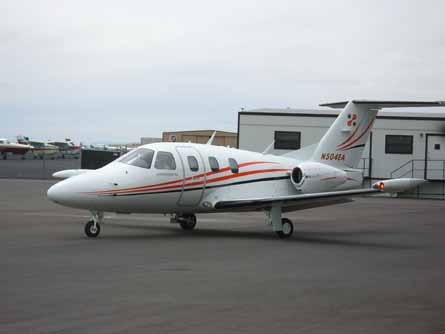 |
| N504EA prepares to start another test flight.This aircraft, which first flew on 21 April 2005, is primarily dedicated to avionics test work |
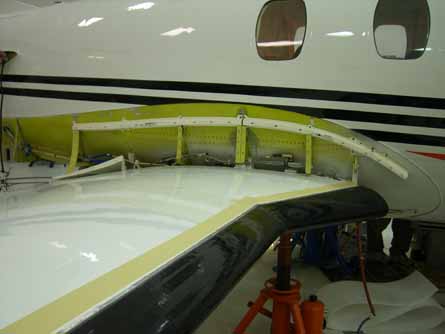 |
| The wing marries to the fuselage with clevis pins at the main spar, one pin at the aft spar and a pin at the forward lift link between the root rib and fuselage lug |
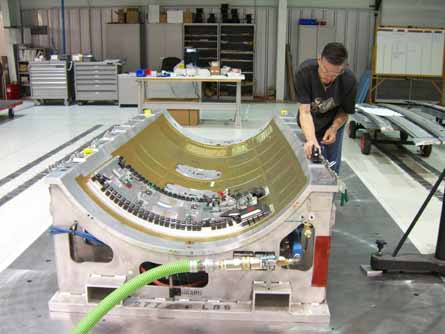 |
| Fuselage skins for the second production aircraft are prepared for friction stir welding |
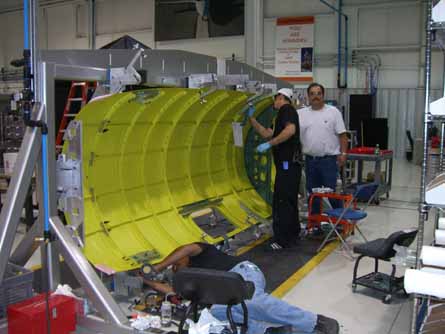 |
| The cabin is made up of four major sub-assemblies, one of which is pictured on the newly developed small production jigs |
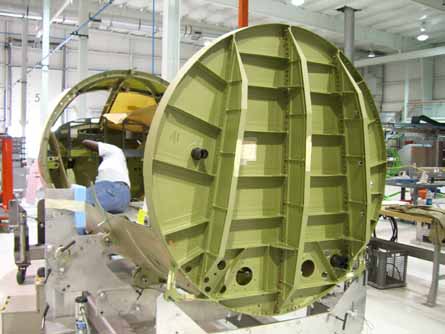 |
| Assembly underway on the fatigue test airframe.The machined aft pressure bulkhead is nearest to the camera |
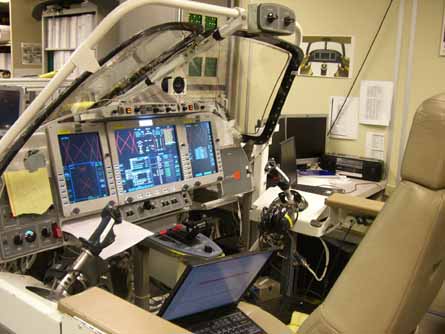 |
| Fault testing for certification compliance is being undertaken at the integration test lab where all the components "talk" to each other for the first time |
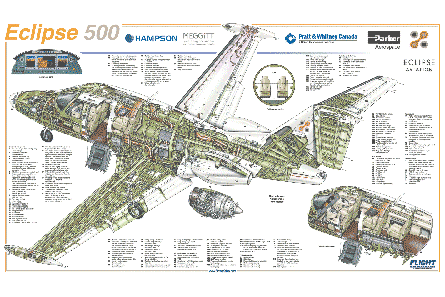 |
| All images © Flight International / Guy Norris |
But as anyone in aerospace knows, the phrase “low-cost jet” is an oxymoron, and to tip the industry on its head Raburn knew he needed breakthroughs in not only propulsion, but also in digital avionics and manufacturing technology. In the mid-1990s, the signs of such breakthroughs were on the horizon and, in 1996, NASA provided the impetus when it launched the General Aviation Propulsion (GAP) programme aimed at demonstrating “a new propulsion system concept for higher performance light aircraft”.
GAP’s aim was to cut the price of small turbine engines by a factor of 10, from hundreds of thousands to tens of thousands of dollars, for four- to six-seat aircraft cruising at 200kt (370km/h) or more.
When pioneering small turbofan company Williams International won the $37 million GAP contract to develop a 700lb thrust (3kN) engine, dubbed the FJX-2, Raburn had the low-cost, high-performance powerplant he was looking for. In May 1998, Eclipse Aviation was founded and partnered Williams on development of the FJX-2-based EJ22 as the exclusive engine for the Eclipse 500.
Eight years and many changes later, Raburn’s premise that the Eclipse 500 is the right aircraft, with the right technology at the right time, is about to face the ultimate test as it nears certification and entry into service.
Hurdles overcome
But in many ways, the Eclipse programme has already proved its mettle, overcoming upsets and hurdles that nine times out of 10 have spelled doom for countless other start-ups. The most severe of these, and one that delayed certification by more than two years, was the decision in November 2002 to ditch the Williams engine and find a replacement following the EJ22’s poor performance in early tests.
Looking back, Raburn has no doubts this was the correct decision. “It was the best thing that ever happened to us. Thank goodness Williams failed, otherwise we’d have never got together with Pratt & Whitney Canada,” he says. The P&WC PW610F, a 900lb-thrust variant of the Canadian company’s new PW600 family of light-jet engines, was selected in February 2003, bringing with it the promise of big engine company backing and support.
Although the overall aerodynamic shape of the Eclipse was unaffected by the change, the switch to a larger and more powerful engine meant that “more than 90%” of the aircraft structure required redesign to cope with the higher weights and loads. Although conceding “it was a massive task, and not without pain and cost”, Raburn says the redesign did not add more delay as Eclipse had already adjusted the development schedule to fit P&WC’s engine delivery timetable.
Despite the late changes, the basic design intent has never wavered from day one, says Raburn. “We drove the design from a system-level safety perspective – it’s the reason why we haven’t had any problems with the FAA on safety.” The full-authority digital engine control (FADEC) unit, for example, was always designed to be mounted inside the pressurised fuselage and away from the engine. “It was a much more benign environment, but the FAA said ‘you’re doing what?’ But we were able to prevail, and it was one of the core historical design decisions we made from the start. And why wouldn’t you?” asks Raburn, whose habit of challenging convention is now as famous – or infamous – as the VLJ concept itself.
“It had interesting ramifications and drove cost out of the aircraft while actually increasing safety,” says Raburn, who adds: “We knew from the beginning we’d have questions about operating safety because of the jet engines. The big lie in aviation is that jets are hard to fly. Turbofan reliability is the ‘big one’ and, quite simply, we’ve figured out a way to bring a new level of safety to a new sector of aviation.”
A firm believer in the precept that all major leaps in aviation are directly tied to advances in propulsion, Raburn underlines his point: “GA is the last sector to benefit from the leap from the internal combustion engine to the turbofan, and this is the brilliance of what we tried to do with the Eclipse. Life just gets better when you convert to turbines.”
Back to basics
For all its in-built technology and sophistication, the Eclipse 500 is a conventionally configured low-wing, T-tail, twin-engined aircraft that is not much larger than a Cessna piston single. The clean design belies what lies beneath the skin and fits well with the tenets of “Moore’s Law” – Raburn’s oft-quoted saying by Intel co-founder Gordon Moore that “the more complex a system is on the inside, the simpler it should be on the outside”.
Structurally, the Eclipse 500 is primarily made from lightweight aluminium alloys, with some secondary structures and fairings being composite. The choice of aluminium over composites is tied directly to Raburn’s strategy for low-cost production, and the use of friction stir welding (FSW) for high levels of automation and tight control of quality. “We also have a high number of machined parts, more than I’ve ever seen on other aircraft,” says Eclipse chief operating officer Peg Billson. “We assemble the aircraft in chunks to minimise weight and cut assembly time,” she adds.
The use of welding, up to 136m (445ft) of joins per aircraft, dramatically cuts the use of rivets – around 7,380 are eliminated by the process. Thanks to automation, Eclipse says up to 1,800h of assembly time can be saved per aircraft. This means an entire shipset can be welded in a single shift, making FSW pivotal to the company’s plan of eventually producing up to four aircraft a day. “We are looking at between 750 and 800 per year, which we could hit next year,” says Raburn, who adds this equates to just over three a day.
“FSW is a very big piece of it, but it’s difficult to say there’s a single technology that makes this work,” says Raburn. “I did a lot of historical analysis of why most start-up companies failed. With the obvious exceptions of the companies like Cirrus, Lancair, Learjet and Robinson, virtually every one fails. One of the reasons is they do something that’s less than 10% better 99% of the time. So the customer says ‘why should I do this if it’s only a little bit better?’ We have to be an order of magnitude better and you can’t do that with only FSW. We had to push and question on every part.”
Initial design life of the airframe is 20,000h, 20,000 cycles or 20 years, whichever comes first, although “as we go through fatigue testing we think we’ll end up with more”, says Raburn. The structure, designed using a combination of failsafe and damage-tolerant principles, has been granted an initial 10,000h fatigue life by the FAA – although formal fatigue tests are set to start in San Antonio, Texas in June. The static-test airframe is now being refurbished as a cabin demonstrator after surviving torture tests that ended up with the test machinery breaking at 193% of the design limit load.
Like a model kit, the Eclipse 500 comes together in final assembly in six major subassemblies, plus the engines. These include the wings, horizontal stabiliser, tail, nose section and cabin. The cabin is assembled from four welded sections including the right and left upper skins, lower skin and cockpit with its distinctive “bird cage” window-frame arrangement. All four subassemblies are conventionally fastened together and to the forward and aft pressure bulkheads, which are machined from one piece of aluminium.
The emergency hatch and window surrounds are machined then welded to the cabin skin sections. In all, 273kg (600lb) of aluminium remains in the machined parts of the airframe from an initial material weight of around 2,725kg, says Billson.
Alloy changes
Principal materials used include Al 2024 sheet alloy for the cabin, lower wing and aft fuselage skins, the latter changed from Al 7475 alloy for improved manufacturability. Al 2124 plate is used for pressure bulkheads, and windshield and window reinforcement, while high compressive-strength Al 7055 is used in extrusion form for fuselage and wing stringers. Al 7150 plate, with high ultimate and compressive yield strength, is used primarily for wing and fin spars, while Al 7475 sheet and plate is used upper wing skins, vertical tail skins and ribs as well as the nose deck.
The machined nose includes keels that support the landing gear, weather radar and cheek formers, and which attach to the forward pressure bulkhead. The keels also support an equipment deck that carries the air-conditioning vapour-cycle system (VCS), batteries, brake and oxygen systems as well as the engine start contactor.
Seat-track keels on the other side of the bulkhead also help carry loads. The start battery and VCS were moved to the nose to rebalance the aircraft with the change to the heavier PW610F. The same centre-of-gravity rebalancing also saw the engines moved forward 250mm.
Seat rails are attached to four longitudinal keels running from the forward pressure bulkhead aft to the wing carry-through spar, which passes under the cabin floor and connects to each wing root via two clevis pins. One pin is located at the aft wing spar and the other at a forward “lift link” to react wing torsion between the root rib and fuselage lug.
The aft fuselage and vertical tail assembly has a similar structural approach to the cabin, with FSW joining of the stringers and frames to the skin. Three skin assemblies are mechanically fastened together with lap splices, as well as to the aft pressure bulkhead and vertical tail assembly. A number of machined vertical spars called “banjo frames” combine the tail with the lower aft fuselage. The aft fairing was originally designed to house a split-tail speed brake, but this was deleted after flight tests showed it was not required.
The two-spar, all-metal wing spans 11.4m and incorporates ailerons and Fowler-type flaps, each of which are controlled by two electromechanical actuators. Although the flaps are not mechanically interconnected, the “smart” actuators cross-monitor their respective positions and automatically adjust their rates to maintain synchronised deployment if a mismatch is detected. The flap has four simple operating positions: up, take-off, approach and down.
The aircraft has a machined two-piece “clamshell” main entry door measuring 0.6 x 1.2m. The upper section opens first and is damped by a gas cylinder, while two cables support the lower section, which includes integral steps that retract when the door is closed. Pins in the upper door insert into the frame to provide failsafe latching, while dual proximity switches alert the crew to any latching problems via the multifunction display.
Emergency exit
A 0.6 x 0.5m elliptical emergency exit is on the starboard side of the cabin and, although a plug assembly, can be opened from either inside or outside the cabin. The one-piece machined exit is also lockable with a security pin to prevent it being opened from outside when the aircraft is not in operation.
Composite wing-to-body fairings aft of the flaps have been reduced in size to improve localised laminar flow. The reprofiled fairing has reduced the drag problem encountered in late 2005. “We had lots of separation, including some vertical flow, and even some flow reversal,” says Raburn, who adds that additional drag-reduction improvements have been developed. These include better door and gap seals, smoother lap joints, more flush rivets, combined antennas and flap-track fairings. The final impact on range is still to be determined, but “we will still go further than the competition”, he says.
Taking in lessons learned from the ageing generation of current GA aircraft, and with the benefit of a clean-sheet design, Eclipse has “all-electric” systems that all but dispense with the need for a maintenance-intensive conventional hydraulic system. The aircraft does have simple master brake cylinders that the crew use by pushing toe brakes on the rudder pedals to activate disc brake assemblies on the main landing gear wheels only.
Electrical power is distributed through six buses, with the electrical power distribution system (EPDS) using electronic controls and circuit protection for safety and reliability. The 28V DC electrical system is powered by two 200A starter-generators and two 24V DC, 24Ah lead-acid batteries with enough capacity to power essential equipment for a minimum of 30min.
A set of five electronic circuit breaker units contains 127 electronic circuit breakers (ECB) that feed power to components of the Eclipse 500’s unique Avio total aircraft integration system. To ensure redundancy, all flight-critical components are each connected to two independent ECBs fed from two separate EPDS buses. The ECBs function as both breakers and switches, while two mechanical circuit breakers are retained to control the pilot-side primary flight display (PFD) and left-side aircraft computer system (ACS). The two mechanical breakers are provided to prevent an inadvertent, and unrecoverable, electric system shutdown.
Fuel is housed in two integral wing tanks with a total maximum usable capacity of just over 870 litres (230USgal), and is fed to the engines for starting by two brushless DC electric pumps. The same pumps, also used for fuel balancing and transfer, are available as emergency back-ups in the event of loss of the own-side boost ejector pump. A series of check valves prevent fuel flowing through the start pump back to the sump tank when the boost ejector pumps are on, and similarly valves in the boost ejector pump lines stop backflow when the electric start pumps are activated. The electric start pumps and check valves are housed in the wing root fairings.
Gravity refuelling is via a fuel tank filler port at each wingtip, “making it very simple from a pilot‘s perspective”, says Raburn. Six fuel capacitance probes and a fuel densitometer in each wing measure remaining fuel and pass the data to the Avio system, which gives the pilot updated range measurements. The fuel system synoptic is also controlled through Avio, which automatically transfers fuel when it detects an imbalance greater than 23kg.
Despite the fly-by-wire look of the sidestick controllers, the flight controls are traditional and mechanically actuated using pushrods, bellcranks, pulleys and cables. “So if you lose all electrical power you never lose control of the aircraft,” says Raburn. The control runs to the elevator and rudder are separated within the engine rotor-burst zone to further enhance safety. “The decision to go with a mechanical flight-control system was a classic trade study, and took advantage of the small size of the aircraft,” he adds.
Straightforward trim
Brushless stepper motors control the electric trim system. “The trimming autopilot is pretty straightforward,” says Raburn, who adds that, in the event of a trim runaway, the system can automatically disengage any trim servo through control monitoring. The pilot can also disconnect and stop all trim movement by pushing an “all-interrupt” switch on the sidestick.
The Eclipse 500’s stubby, but sturdy, landing gear consists of two trailing-link main landing-gear legs and a steerable nose gear. Electromechanical ballscrew smart actuators operate the gear, which is controlled through Avio. An emergency gear-release lever disengages the servo motor, allowing the gear to freefall into a down and locked position. If needed, the emergency extension system can be reset in flight and the gear retracted.
Braking is by conventional disk brakes and no anti-skid system is thought necessary. “At the weight and speeds, and with the sort of tyre pressures we operate at [95lb/in2 main, 70lb/in2 nose], we stay out of the hydroplaning zone apart from the first couple of seconds after touchdown,” says Raburn. “For the same reasons we have no thrust reversers and no thrust attenuators because we have extremely low ground idle. Nature loves miniaturisation.”
The environment inside the Eclipse cabin is metered by the climate control system (CCS), which is integrated to look after cooling, heating and oxygen levels as well as pressurisation. The system maintains a cabin altitude of 8,000ft at 41,000ft cruise altitude – a 0.56bar (8.25lb/in2) maximum cabin pressure differential. “A 6,000ft cabin altitude would have required more bleed air off the engines and we decided it wasn’t needed,” says Billson. The system includes two outflow valves mounted beneath the baggage compartment floor on the aft pressure bulkhead. The master valve contains software for scheduling and signalling the valve functionality to Avio via the ACS. Eclipse designed the system so that, in the event of a power failure, the valve will automatically default to a mechanical protection logic circuit to keep cabin pressure within prescribed safe limits.
Having worked with BMW Group Designworks USA to bring automotive design principles to bear on the cabin, Eclipse again turned to the car industry for “best practices” when it came to the cooling and heating control, says Raburn. The design team “spent a lot of time” in the parking lot outside the Eclipse headquarters checking out the design of environmental control systems in “BMW, Mercedes and Lexus” cars as part of the process. “We decided if people can use and understand the climate control system in a car then we can easily do it in an aircraft. This is one of the most complex systems in the aircraft, with about eight motors and around 18 valves, but it works very well,” says Raburn, who adds that the “software to drive this has been in development for three years”.
The result is a system with independent temperature control for the cockpit and cabin, both of which are controllable using the multifunctiion display. Air conditioning and de-humidification is provided by the VCS, which has a sealed-scroll compressor powered by a brushless DC electric motor, a fan-equipped refrigerant condenser and a receiver-dryer unit. Evaporator and fan assemblies are installed in both the cockpit and cabin. The standard oxygen system, consisting of a 0.62m3 (22ft3) cylinder, quick-donning pilot’s mask and five emergency passenger drop-down masks, can be upgraded with a larger optional 1.13m3 cylinder and co-pilot mask.
The cabin itself, with the look and feel of a luxury car interior, has the kind of seat every crash test dummy in the automotive industry would die for. Developed for maximum crash survivability, the cockpit seats can withstand 26g dynamic forward loads, while the track-mounted cabin seats can take forward loads up to 21g. Cockpit seats have five-point restraining belts with a rotary release buckle, while cabin seatbelts are three-point shoulder harnesses. A 0.73m3 baggage area, which is pressurised and heated, is accessible in flight.
Along with advanced manufacturing and engine technology, the Avio total aircraft integration control suite is the third pillar on which the Eclipse 500 achievement is being built. Although its development has not been easy, the Eclipse-designed system is seen as one of the breakthrough technologies behind the viability of the VLJ, largely because of the reduced pilot workload and safety benefits the system offers, but also the increased levels of reliability that should result.
Central control
Resembling the level of sophistication previously only seen on advanced military aircraft, Avio enables the pilot to centrally control virtually all aircraft systems and functions. “It was designed from the ground up and is driven far more by computer technology than aircraft technology. Aviation is about two decades behind desktop computing and there’s a whole world out there that’s attracted the best and the brightest that aviation hasn’t,” says Raburn. “As far as the machine-human interface goes it’s been like the evolution of fruit flies and the evolution of alligators. So we’ve tried to steal, plagiarise and learn from the developments that were going on out there.”
Avio product manager Matt Brown says: “It’s not just cockpit integration, it is total aircraft integration and it is all for safety.” He says two key philosophies guided the design for reduced pilot workload. “First, we only present useful information, not just data. We only display data the pilot can do something about. All the rest are filtered out or used on the ground only for maintenance. Second, the system should serve as a virtual co-pilot during all phases of flight. There isn‘t a thing that happening on this aircraft that it does not know about,” he adds.
The system is built around dual aircraft computers, two FADECs per engine, a fail-passive three-axis autopilot, the autopilot control panel and dual integrated sensor suites. These, in turn, work with data from the attitude heading reference system and its magnetic azimuth detector, wide area augmentation system (WAAS)-capable GPS and air data system. Avio includes the dual 10.4in liquid crystal PFDs and 14.1in multifunction display, as well as the pilot’s data entry keyboard.
The result, says Raburn, is that “people have always said the Eclipse is the easiest plane they’ve flown – melting an engine on this aircraft is not an option because it won’t let you. That’s why I lose patience with people who say they think it is going to be dangerous – they haven’t taken time to learn how the system defers that moment of task saturation and dramatically relieves the workload.”
Pratt & Whitney Canada’s PW610F flew for the first time on 16 December 2004, mounted on the Canadian company’s Boeing 720 flying testbed, and began powering the Eclipse test fleet just 15 days later. Flat rated at just 900lb sea-level thrust up to ISA +10°C (77°F), the PW610F is the smallest member of P&WC’s new PW600 series, which includes the PW615F powering Cessna’s Citation Mustang, and the PW617F selected for Embraer’s Phenom 100. These are the founding members of what P&WC intends as a new family of lightweight, low-cost turbofans in the 900-3,000lb thrust range.
Built-in APR
The diminutive PW610F has a 365mm-diameter, one-piece solid titanium fan; an axial-centrifugal high-pressure (HP) compressor with one mixed half-axial/half-centrifugal stage and one centrifugal stage; and single HP and low-pressure (LP) turbine stages. The PW610F is the only engine in the series that features a built-in automatic power reserve (APR). This is automatically triggered by the Avio system if it detects a power reduction in one engine and needs no input from the pilot. The APR provides up to 10% (90lb) of additional thrust to the normal operating engine. While APR is engaged, the FADEC automatically prevents the higher thrust engine from exceeding any limit that would require a maintenance action.
Thrust control is provided by an autothrottle, which reacts to pilot inputs via the autopilot control panel. In response to these settings, brushless motors move the throttle levers to the correct position, which prompts the FADEC in turn to send the appropriate control input to the engines. Brown says the closed-loop autothrottle, a system not seen before on a small aircraft like the Eclipse, “is not supposed to be used for landing and take-off, but will bring you all the way down to the approach”.
Supported by P&WC, the PW610F will come with an initial time between overhauls of 3,500h, with a hot section inspection at 1,750h.
Another Eclipse innovation is the PhostrEx engine fire-suppression system, which is expected to be more effective, simpler, lighter and less expensive than conventional Halon systems. PhostrEx is also more environmentally friendly as it does not release any ozone-depleting chemicals. PhostrEx works to chemically shut down a fire in less than a tenth of a second, then combines rapidly with moisture in the air to become inert “before it can be transported to the stratosphere where ozone depletion could occur”, says the company. Because the material is far more potent than Halon, much less is needed.
“We got a phone call from an inventor called Dr Peter Haaland who said he had a ‘better mousetrap’,” says Raburn. “We were in the process of bidding the fire-suppression system and looking at $7,000-10,000 installed costs, and were getting depressed when Peter literally walked in.”
PhostrEx works by releasing bromine atoms that catalyse a recombination of reactive chemicals in the flame, shutting off the heat release and extinguishing the fire. While Halon releases the bromine reluctantly, PhostrEx decomposes about 1,000 times more rapidly in a fire. “Two teaspoons of PhostrEx are equivalent to two and a half cups of Halon,” says Eclipse. The system is expected to stay on wing for 10 years, and will weigh in at around 3.2kg per side, against 7kg or more for the Halon-based alternative, says Raburn.
The long-awaited certification of the Eclipse 500 now beckons, and is expected by the end of June. Three primary instrumented certification test aircraft and two “beta-test” aircraft, one of which has since assumed more of a test role, have been involved in the rigorous effort that – as of late April – was approaching 1,150 flights and more than 1,600 flight hours.
With just over 2,400 orders, Eclipse is well into the build-up ready to begin production at its expanded Sunport site at Albuquerque airport in New Mexico. Raburn is also ready to “pull the trigger” on even larger production facilities at the nearby Double Eagle II airport, which are expected to be fully functioning by 2010.
The final decision lies with the dramatic numbers that may only come if the corporate, same-day logistics, air taxi, owner-operator, training and overseas markets flourish as Eclipse hopes. Although the owner-operator, corporate and to a lesser extent air taxi, training and overseas markets have begun to show promise, Raburn cautions: “I’m pretty optimistic, but some of these markets don’t exist, and I have to see the whites of their eyes before committing to the next production expansion.”
Meanwhile, former Microsoft executive Raburn is adamant aviation will realise his dream to change the value proposition to “make it better and charge less. That’s the world I came from. I’ve come from an industry that’s gone from making thousands of PCs per year to making a couple of thousand PCs per hour.” The message is clear: “Look out for the Eclipse 500. Coming soon to an airport near you.”
Source: Flight International























